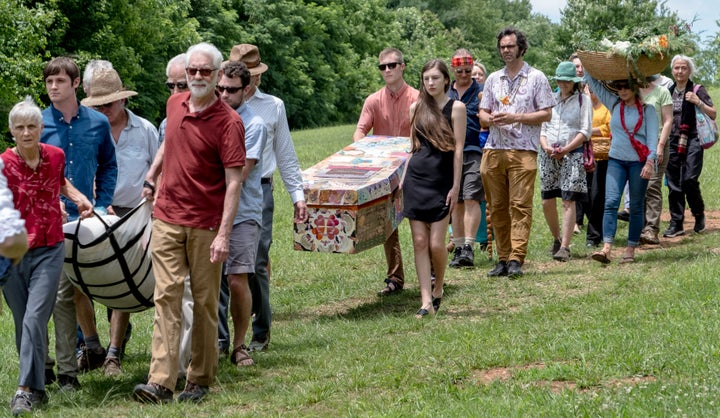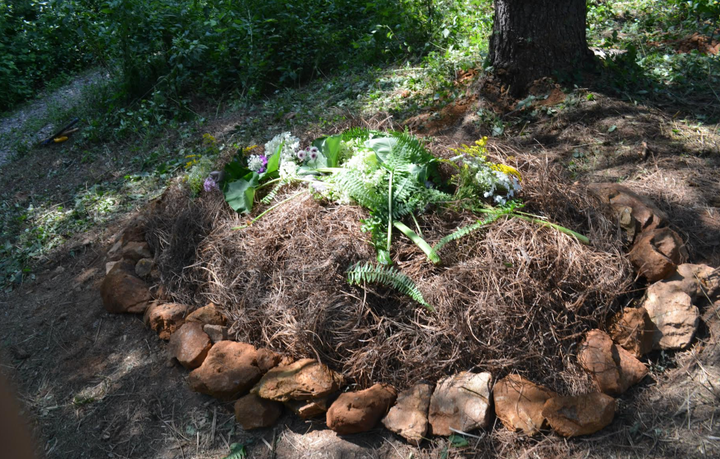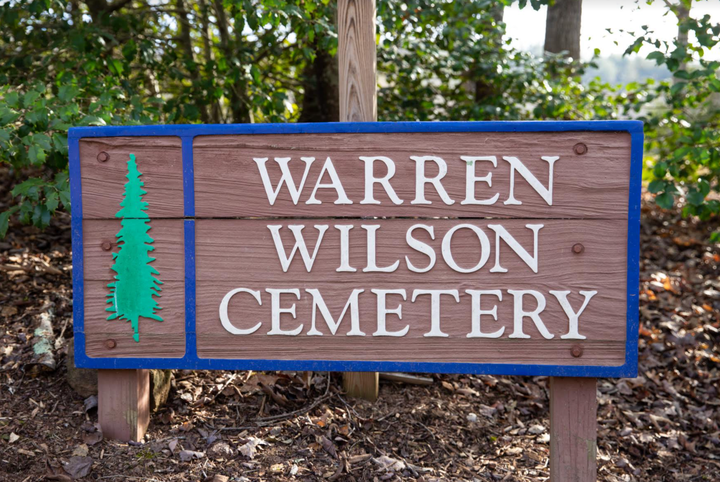
We were late. It was just a potluck, so our tardy arrival shouldn’t have mattered. But the dinner was in honor of a woman named Yvette, who used a wheelchair and was dying of cancer. Time felt precious. With my teenager in the passenger seat, I spun the car into the parking lot at Holding Space, a nonprofit that provides a home in Asheville, North Carolina, for those facing death without family or finances — so they could die in a community rather than alone.
As we walked up the steps of the house, casserole in tow, my daughter turned to me, desperation in her eyes. “Pul-leeze don’t ask the dying person about plans for her body,” she asked. “Just leave it this one time.”
This event was one stop in my yearlong journey to revise my final wishes with climate change and community in mind. So I’d been talking a lot about “death plans” with both strangers and friends at the small college where I live and teach environmental education in the Appalachian Mountains. The impetus for my research was the climate crisis — as well as my parents’ sudden deaths after they were both hit while cycling, in separate accidents two years apart, by teen drivers.
One month after my mother died at 58, my father read aloud his two pages of directives to his grown children: He wanted a funeral that relied on family and friends, without embalming or a concrete vault. Instead he asked for a pine casket, my mother’s linens as a shroud, his bluegrass band by the gravesite and shovels so young and old could fill the grave.
My dad was a detail guy.
When he was killed, two years later, I screamed the F-word in my front yard until a student came to check on me. In our shock, my three siblings and I found grounding and momentum from his instructions. I wanted to give that gift to my two daughters, 14 and 21, whenever I died.
For myself, I’d chosen flame cremation due to its convenience and affordability, key factors for me as a single mom living in a 900-square-foot rental duplex on campus. But at 55, I’d recently realized that options for my body went beyond burial versus cremation. My research revealed one primary lesson: We now have more sustainable choices for our bodies after death and the power to advocate for these options in our communities.
Of course, these decisions depend on factors like geography, culture, finances and religion. Still, options like green burial, aquamation and human composting are expanding quickly across this country. We know that 100 companies are responsible for 71% of global greenhouse gas emissions, so my one death won’t stop the climate crisis, but it can heal relationships with death and contribute to collective momentum for the climate.

Green Burial In Conservation Cemeteries
When I volunteered as a parking attendant one summer at Carolina Memorial Sanctuary in Mills River, North Carolina, I learned firsthand how this conservation burial ground sustains the land in perpetuity through conservation easements that serve as legal protection from development. Unlike manicured cemeteries, these burial grounds look like nature preserves with public paths for walking. The cost for a plot here is $3,500, and the family can transport the body to the site or pay for services from a funeral home.
Green or natural burial doesn’t use embalming, vaults to line the grave or materials that aren’t biodegradable. The Green Burial Council provides locations of the conservation cemeteries across the country. In contrast, conventional burials often operate more like landfills than resting places, with embalming chemicals, metal caskets and concrete vaults underground. Price comparison requires asking about specifics, but the median price for a conventional burial with casket and full funeral services is $7,400.
Natural Burial In Local Cemeteries
My father’s green burial was possible because he read the fine print of his cemetery contract. It didn’t require vaults, which are often stipulated to keep the ground level for mowing. That local burial ground could have been classified as a hybrid cemetery, which allows both conventional and natural burial. Again, the Green Burial Council’s interactive maps show these sites, but you can also just read the contract, as I did for the burial ground on the campus where I lived.
Aquamation And Flame Cremation
With some trepidation, I’d asked several funeral directors if I could observe a cremation, but I watched YouTube videos instead due to privacy concerns. More than 50% of Americans choose flame cremation, with that number expected to grow to 80% by 2040. Yet conventional cremation uses fossil fuels to reach temperatures of 1,600 degrees Fahrenheit for several hours. The median cost for no-frills cremation without a funeral service is $2,400, with aquamation it’s about $150 to $500 more.
In western North Carolina, I interviewed funeral directors who intended to invest in aquamation, or alkaline hydrolysis, which uses water and lye to accelerate decomposition with one-tenth of the energy required for flame cremation. Aquamation, which was chosen by Desmond Tutu, results in liquid and bones, which are crushed to resemble the “ashes” from flame cremation.
“Everybody thinks alkaline hydrolysis is the future of cremation,” said funeral director Scott Groce. The process is available in about 20 states, although it’s been used for cattle and pets for years.
Body Farms And Human Composting
During my research, I discovered a body farm less than an hour away at Western Carolina University’s FOREST (Forensic Osteology Research Station). There I spent time in the lab at one of seven body farms in the United States, where researchers and students study human decomposition. In contrast to donations for medical research, body farms don’t embalm the remains, and the only cost is transportation of the body to the facility. For every friend who’s told me, “Just leave my body in the woods,” I now had an option for them.
Research at the body farm contributed to the science behind human composting, now legal in Washington, Oregon and Colorado, in large part due to the efforts of Katrina Spade at Recompose. This process composts human bodies and generates 1.5 to 2 cubic meters of carbon-sequestering soil ― several wheelbarrows full ― as a byproduct, for a cost of $5,500. Nutrients in deceased bodies support life, saving an estimated 1 metric ton of carbon over standard burial or cremation.

In one year, I volunteered at the nearby conservation burial ground, attended home funerals, interviewed end-of-life doulas and funeral directors, observed at a body farm, explored human composting and discovered a cemetery at the college where I teach. I’d lived on campus for 20 years and had never realized there was a resting place for the college’s founders and their families. It all started with asking questions.
The only problem was the Warren Wilson Cemetery, where I considered being buried, required vaults, which I didn’t want to be used for my body. And the 86-year-old trustee of the cemetery, retired math professor Ray Stock, wasn’t keen on being told what to do by a youngster in her 50s who was interested in greening the burial ground. As a Southern-born feminist, I even offered to cook dinner for the three trustees in exchange for a discussion about green burial. But Stock wouldn’t budge.
I didn’t intend for the story to end on a Zoom call in a pandemic with the cemetery trustees and the Rev. Steve Runholt, pastor of the Presbyterian church that owned the land. We gathered online to discuss my request for an exemption to the vault requirement, based on my religious beliefs as an Episcopalian to care for creation.
One of the trustees suggested the committee meet at the cemetery for a vote. The next day, Runholt left me a voicemail: “The trustees voted not to grant a one-time exemption for you.”
I sighed, disappointed and confused, until he continued. “But they voted to change the policy and allow green burial at the Warren Wilson Cemetery!”
One month later, Ray Stock’s cancer took a downturn, and he died at his home on campus. But he’d given the other trustees the big yellow poster board with all the names and plots. His family set up a fund to maintain the burial ground in his honor.
In the end, I also learned that the most important thing we can do — for the climate and our deaths — is to talk about both with those we love. It’s not too late to carry the love of the people and places we want to cherish forever.
Mallory McDuff is the author of four books, including her most recent, “Our Last Best Act: Planning for the End of Our Lives to Protect the People and Places We Love,” published by Broadleaf Books. She teaches environmental education at Warren Wilson College in Asheville, North Carolina. Her essays have appeared in The New York Times, The Washington Post, Wired and more.
Do you have a compelling personal story you’d like to see published on HuffPost? Find out what we’re looking for here and send us a pitch!
